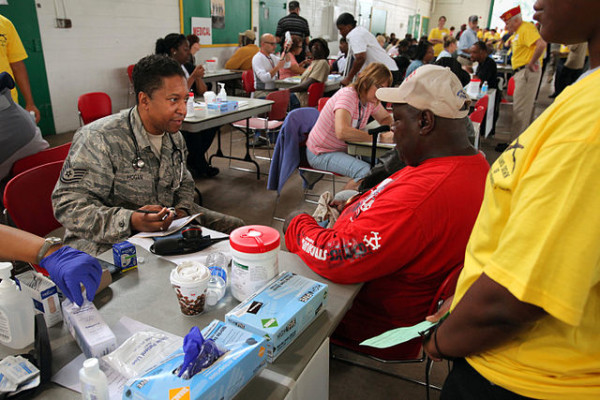If one could measure the speed of pedestrians pattering on the sidewalk, one would probably notice the footsteps slowing down or speeding up near certain hotspots. Not near intersections, but where the newspaper-blanketed homeless huddle behind their signs.
With their mouths dried out from asking each passerby, these homeless etch their pleas on cardboard. “Hungry hungry homeless”, one sign reads, a reference to a children’s game, Hungry Hungry Hippo. Many others read, “homeless veteran.”
Unshaven, gaunt figures in grimy military fatigues affix their eyes to plastic buckets.
There is something sinister at work here: countless movies such as Saving Private Ryan laud the gallantry of the soldier. And yet here are these people—people who could be war heroes—begging not for fame and glory, but for sustenance.
Image Source: Robert Ginn.
Clara, a college counselor, hinted over a phone interview that the fault lies not with these veterans, but with a tangle of miscommunications.
Clara works for a liberal arts college on the east coast, advising veterans on their college integration. She states that, without exception, all of the currently enrolled veterans were community college students fortunate enough to have another individual’s encouragement to gain further credentials, such as a bachelor’s degree.
“They haven’t heard about the resources to ease their transition into a 4-year program. They hear about these colleges that support veterans mostly through a professor, or a trusted mentor. They wouldn’t consider going beyond an associate’s degree and seeking other opportunities otherwise,” Clara continues. “In this, the government fails to connect veterans seeking higher-education with colleges.”
It is not that they were too dumb to realize their futures. When they are no longer soldiers in a well-oiled machine, they come back and feel disconnected in their new “civilian life”. This disengagement with their community becomes more problematic as wars wind down and more veterans return home.
“They have difficulty transitioning in terms of guidance,” Clara explains over the phone, brimming with compassion for her students. I can sense how her charges would be comforted by wisdom meted out so patiently. “In the armed forces, everything is directed. Every moment of your day is governed, and there is a sense of importance. ‘Colonel, deactivate this IED’. There is this urgency to saving lives. And then you come back, and have to struggle. It makes what you do in life seem not as significant sometimes.”
They also face this weird judgment from civilians saying, “We support you troops, but we don’t support the war.” This creates a general attitude of ambivalence in which veterans are not thanked for their service.
“How are they supposed to feel consistent about how to feel about themselves when society isn’t?” she queries.
Image Source: Brendan Smialowski.
Specifically at the college Clara works for, age disorients veterans fresh out of the battlefield. Many college events and activities are made for 18-22 year olds. However, like other nontraditionals transfer, veterans’ ages can range between 22 and 35. For the few who take advantage of the G.I. Bill and matriculate into a college, they might still feel disconnected from the college community.
Daily things that we don’t think about can be challenging for them, Clara continues to explain. For example, when the Asian Student Association hosts annual fireworks, they have to send out notices, because these fireworks can become triggers for veterans. Sometimes, a car door slamming startles student veterans. These student veterans may not display a physical reaction, but could react mentally instead. These are things that we civilians take for granted every day, and some counselors try to advise veterans on about these issues.
I ask Clara towards the end of our conversation, “So do you think that the government, particularly on the public health system, fails our veterans on some regard?”
She pauses, and then agrees, somewhat reluctantly, that the main fault seems to be this lack of connection immediately after these veterans return from war. They should be connected to a mentor, she states, and not left calling the V.A. (Veteran’s Affairs) with precious coins and subjected to a 5-8 month holdup for addressing some injuries from the battlefield, such as PTSD. She transitions to talking about mental health issues, pointing to the huge need for a overhaul in treating PTSD in veterans.
“History repeats itself,” she mourns. She cites a clear “lack of psychological support” — sometimes, it is a pharmaceutical issue, where more pills than necessary are prescribed.
She wraps up the conversation with a strong vote in these students’ favor. “These students are going to be future leaders. If you help them now, they will be able to help more people. There’s a multiplier effect.”
“Go to local VA, check it out. Veterans hang out in clubs. Buy them a beer, and if you’re friendly, they will talk to you.”
So I took her advice, and talked to a veteran here, on our own West Coast. (Part 3).










